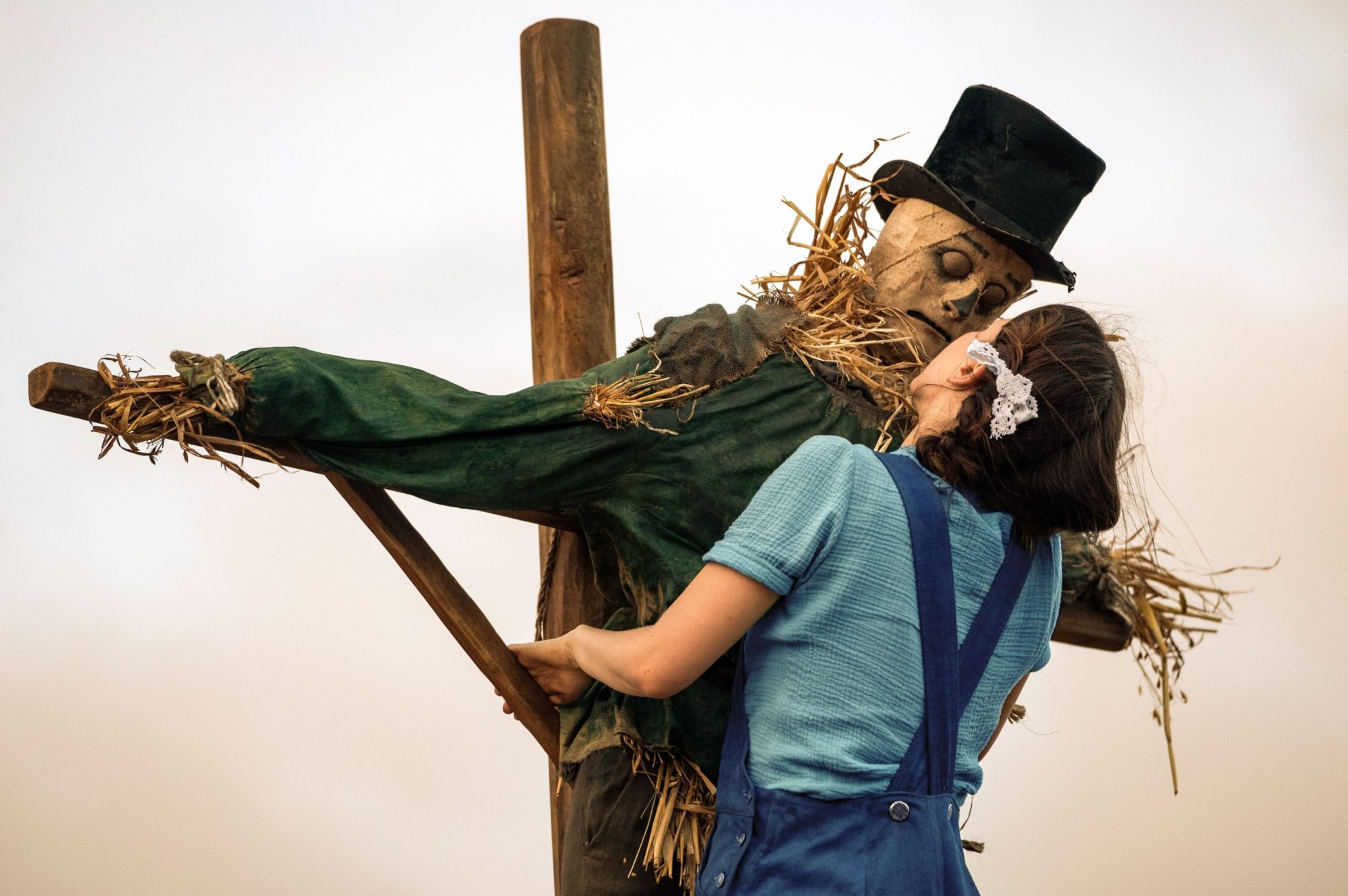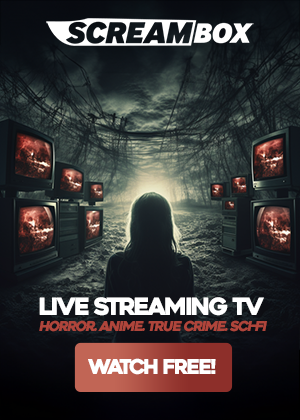Editorials
No Place Like Home: The Cinematic Parallels of ‘Pearl’ and ‘The Wizard of Oz’

Heads up! This piece contains MASSIVE SPOILERS for the movie Pearl. We kindly “axe” that you see the movie first and come back to read this after.
We all know the story. The story of little Dorothy Gale and the adventure she has when she’s whisked away to the wonderful land of Oz. The Wizard of Oz is one of the most timeless pieces of American literature ever produced, and the 1939 film adaptation remains one of the greatest (and most frightening) films of all time. This has caused numerous filmmakers of all genres and backgrounds to be inspired by the classic story in different ways over the years. Ti West brings it to a whole other level with his new film Pearl, the prequel to his slasher movie X that tells the story of the titular character and her descent into complete madness.
The film is littered with parallels calling back to the classic 1939 film The Wizard of Oz, showing how the fairy tale story can be used in a different context to what we’re used to.
Right off the bat, the aesthetic and filmic style choices call back to the era of technicolor filmmaking. Technicolor is a process of filming color movies that dates back to 1916 and uses a three-strip system in which a modified camera would capture footage through different color filters (typically red, green, and blue), and be processed separately so that each strip would “print” various colors onto a finished print of the film. The result was a vivid display of color not commonly seen in this era of filmmaking, though one film in particular became famous for its use of the process: The Wizard of Oz. Pearl pays tribute to this by using a vivid color palette of bright reds, greens and blues, visually evoking the spirit of The Wizard of Oz.
From here we’re introduced to Pearl (Mia Goth), a lonely farmgirl who lives a quiet life on her family’s farm. She helps take care of her invalid father and is chastised constantly by her overbearing mother, Ruth. She dreams of a better life but her husband is fighting in World War I and her predicament has her with no place else to go. Pearl is a mirror image of Dorothy Gale from The Wizard of Oz (right down to the pigtail braids). In that film Dorothy lives on a farm with Auntie Em and Uncle Henry and dreams of someplace “over the rainbow “ to escape the mundane life that she leads.
Pearl then rides into town on her bicycle to fetch her father medicine. When she gets to town we’re presented with a whole different world than the one Pearl is accustomed to. There’s music playing and people freely living their lives, and Pearl’s troubles melt away with an escape to the movie theater (with a side of micro-dosing). While here she also meets the projectionist (David Corenswet) of the theater she frequents (more on him later). This runs parallel to the iconic scene in The Wizard of Oz where Dorothy is whisked away to the land of Oz. From the muted, drab palette of her sepia tone world to a technicolor fantasy only possible in dreams.
As Pearl heads home she by happenstance is led into a corn field that is home to a scarecrow that oversees the field. Curious, Pearl begins seductively talking to and dancing with the scarecrow, ultimately leading to a scene where she plays out a sexual encounter with it and imagines the face of the projectionist before having a violent outburst informing it that she’s married. Ashamed of what she’s done she heads back home with the scarecrow’s hat in tow.
The scarecrow’s design is obviously very much inspired by the design that was used on actor Ray Bolger in The Wizard of Oz. A noted dancer while he was alive, the filmmakers gave his character a dance number when he was introduced and Pearl repays the favor by having them share an intimate dance. Something to note is that the 1939 film’s script has an ending scene where the Scarecrow’s human counterpart, Hunk, leaves for agriculture college and Dorothy promises to write to him, implying a romantic connection.
After a visit from Pearl’s mother-in-law and sister-in-law, Misty (Emma Jenkins-Purro), she learns of a local troupe that’s holding auditions for their traveling show. Seeing this as her opportunity to escape her provincial life, she confronts her mother about auditioning for the dance troupe. Her mother has a violent outburst in response and talks about how she sacrificed everything to take care of Pearl’s father, including her dreams and goals. The argument reaches a boiling point when Pearl fights with her mother over the fireplace and mom’s dress ignites, setting her ablaze. Acting fast, Pearl proceeds to throw water on her screaming mother, enveloping her in a cloud of smoke, and throws her down into the cellar to die. This is the scene where we see Ruth evolve from the Auntie Em stand-in to a twisted metaphor for the Wicked Witch of the West, complete with a recreation of the climatic scene where Dorothy throws water on her and kills her in the process.
Pearl runs away into the arms of the Projectionist at the theater where they share an intimate love scene, despite her being married, and he also promises to take her to Europe. The next day he offers her a ride to her house so that she can prepare for her big audition. When he hears Pearl’s mother in the basement he confronts her and eventually catches her in a lie and decides to leave, suggesting he has no interest in seeing her again despite their quickly developing romance. Feeling scorned, Pearl snaps and proceeds to stab him in the heart, submerging his body (and car) in a nearby swamp. The Projectionist is a cold, heartless bastard in Pearl’s eyes, the movie’s twisted version of the Tin Man who infamously has no heart. She gets revenge by destroying his heart. It’s important to acknowledge that he’s the only character who shares any sort of intimacy with Pearl, an act usually only reserved for those in love.
In the final act, Pearl dons one of Ruth’s dresses – a long red dress as a twisted subversion of Dorothy’s iconic short blue dress that she wore when she visited Oz – and heads to her audition. After not getting the part in the troupe, Pearl and Misty head back to the farm where Pearl breaks down and confesses everything she’s done while also revealing her resentment for her husband for abandoning her and heading off to war. The dance troupe was to Pearl what the hot air balloon was to Dorothy, total wish fulfillment and an escape to the life that she deserves. Frightened of her confession, Misty attempts to leave as Pearl confronts her about making the dance troupe and not telling her. Misty in this scene could be viewed as being evocative of The Wizard of Oz‘s Cowardly Lion in her fearfulness of Pearl, and her hair also feels to be a nod to the curled locks that the Cowardly Lion sported in the original film.
After brutally murdering Misty with an axe, Pearl vows to “fix everything” and assembles the corpses of her parents at the dinner table to show that in her mind, things can return to normal despite everything that happened. Howard arrives home from war to find the rotting corpses in the dining room and Pearl donning her farmgirl look from the beginning. Knowing what we know from X, she never leaves the farm. Doomed to spend the rest of her days in a mundane existence and not living the life she felt that she deserved. At the end of the day Pearl realizes…
“There’s No Place Like Home.”

Editorials
Before “Monster High” There Was Rick Moranis in “Gravedale High” [TV Terrors]

For this month’s installment of “TV Terrors” we revisit the short-lived animated series “Gravedale High” (aka “Rick Moranis in Gravedale High“), which aired on NBC in 1990.
During the era of Saturday Morning Cartoons, there was always this idea by studios to build on a big star’s name by giving them an animated vehicle. We saw it with Mr. T, Chuck Norris, Macaulay Culkin, and Gary Coleman, as well as comedians like Louie Anderson and Howie Mandel. John Candy got (the still celebrated) “Camp Candy,” while his SCTV colleague Rick Moranis headlined his own animated horror comedy series for kids: “Gravedale High.”
Rick Moranis garnered immense fame and cult status in the eighties and nineties with an iconic comedy career that carried over into big films like Ghostbusters and Honey, I Shrunk the Kids. As a means of marketing off his momentum, an animated series was developed by NBC and Hanna-Barbera to help broaden his family friendly image going into a new decade. “Gravedale High” was born, an animated series that channeled the classic Universal Monsters and teamed them up with a human out of his element; Moranis, naturally.
Rick Moranis starred as Maxwell Schneider, a well-intentioned teacher who presides over a class of young monsters; and the only human among the colorful cast of monster characters. The series provides literally no backstory to explain how he’s found himself teaching at the titular Gravedale High, mind you, but it’s a fun gimmick that the writers run with all the same.
Even though they’re rarely mentioned, we know who these students are modeled after. Among Schneider’s monster class there’s Vinnie Stoker, a Fonzie-like teen version of Dracula. Frankentyke is a shorter, grouchier version of his monstrous father who is prone to bullying others. Reggie Moonshroud is a geeky red haired werewolf very similar in nature to Ron Howard. There’s also J.P. Ghastly III, a blue skinned gnome similar in appearance to Peter Lorre. And my favorite: Gill Waterman, a Spicoli-esque creature from a lagoon who lives and breathes for surfing.
And then there’s Cleofatra, a heavier female version of the mummy who is the antithesis of normal mummies and, as per the rules of the ’90s, obsessed with food. Sid is the class clown who is based on the Invisible Man. He compensates for being invisible by telling non-stop jokes and playing pranks. Rounding out the class, there’s the Southern zombie with an obsession for shopping named Blanche, as well as Duzer, the snake haired Gorgon who is also a vain, self centered Valley Girl.

While similar to “Scooby Doo and the Ghoul School,” Hanna-Barbera developed “Gravedale High” more like a teen sitcom in the vein of “Head of the Class” or “Welcome Back, Kotter.” Schneider always had a lesson to teach his monster class, with each episode mostly serving as a self-contained comedic misadventure. Despite being hopelessly outnumbered, Schneider viewed the students as more than just monsters, and always inspired them to do the right thing. Despite the students clashing with one another and giving Max a hard time, they also had a real sincerity toward him that made their whole dynamic a lot of fun.
Equally fun was the show’s ensemble voice cast, which included the likes of Shari Belafonte, Jackie Earle Haley, Ricki Lake, Maurice LaMarche, Ruth Buzzi, Charlie Adler, Frank Welker, and so many more.
While Rick Moranis’ career continued on, sadly the series only lasted for just thirteen episodes before cancellation; that can mostly be attributed to NBC dropping all of their kids shows altogether in the mid-nineties, in favor of a more teen oriented, live action line up. “Gravedale High” did manage to re-appear in syndication on occasion, however, and spawned a small line of McDonald’s kids meal toys that are still highly coveted by fans to this day.
While Moranis sadly retired from show business in 1997 to focus on his family, I’d still love for someone to revive this series with new characters and a more modern approach. A new generation of budding horror fanatics could use a show like “Gravedale High” in their lives.
Where Can I Watch It? Criminally, the series is not available to stream and you won’t find any official physical media releases in print, but full episodes can be found on YouTube.














You must be logged in to post a comment.